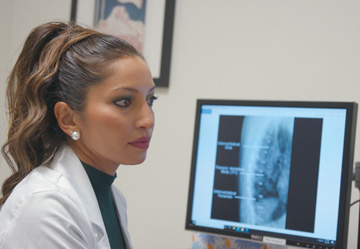There are an increasing number of new procedures that show promise in treating chronic pain. For instance, Dr. Ross was involved in the clinical trial of a procedure that just received FDA approval. The trial involved a stimulator implanted in the multifidus muscles to treat debilitating chronic back pain in younger patients who haven’t responded to epidurals, trigger point
injections and rehab. The stimulator works to rehab core muscles of the back and has been labeled as a restorative therapy because it reverses muscle atrophy and works to help the patient become much closer to where they should be functionally,
according to Dr. Ross. “It has FDA approval, so the agency thought it was very helpful,” he says. “If it does pan out in the long term, this would be a new treatment for back pain that could easily be done in an ASC setting.”
This type of procedure has tremendous potential to help chronic pain patients younger than 65 who are traditionally treated with radiofrequency lesioning, a treatment that can have long-term consequences. “Radiofrequency lesioning in a younger
person will actually denervate the multifidus muscle, so it may provide some benefit in the short term, but in the long term it can harm the patient,” says Dr. Ross.
• Appropriate staffing. Effective chronic pain management programs rely on multidisciplinary communication among diverse clinicians, and it all starts with having multiple dedicated pain specialists on staff. “Ideally you should
have at least two pain specialists, so that when one goes on vacation, you don’t need to stop scheduling procedures,” says Dr. Ross.
There are an increasing number of specialists board-certified in pain and another specialty, such as anesthesiology, who bring a well-rounded perspective to chronic pain management programs. All pain physicians must have strong skillsets in assessing
a patient’s health history, understanding intricate anatomy and reading complex imaging, according to Dr. Wahezi.
Chronic pain programs need a deep and diverse staff of clinicians to thrive. “Facilities should have a psychologist or psychiatrist, a behavioral therapist, a dedicated nurse or physician assistant to facilitate case volumes, and a robust
specially trained nursing staff,” says Dr. Wahezi. He also points to the importance of having an airway management expert on staff to maintain patient safety.
Dr. Ross also touts the importance of education and specialized skillsets in chronic pain staffs. “Personnel training is extremely important,” he says. “My nursing staff services pain medicine clinics and procedures, and they
all have the ability to handle specific and complex physician preferences.”
• Securing reimbursements. Facility leaders aren’t the only ones who have noticed the surge in chronic pain management programs and procedures. “The dramatic increase in utilization has caught the attention of CMS and many
private insurers,” says Dr. Ross. “You can treat patients, but getting reimbursement for implants and procedures is becoming more difficult.”
To avoid unnecessary scrutiny from payers, Dr. Ross suggests facilities keep a close watch on the ratio of pain procedures to follow-up visits. Case volumes that are 80% procedures and 20% follow-up or medication-management visits tend to draw
the attention of payers, according to Dr. Ross, who says a credible practice is about a 50/50 or 60/40 mix.
Dr. Wahezi agrees that insurance companies are being a bit more careful about how they reimburse chronic pain management programs and are implementing more stringent checkpoints that facilities must go through to secure payments. “Insurance
companies want these procedures to have patient satisfaction metrics and objective measurements to back them,” he says. Dr. Wahezi says the benefits of a procedure can be measured with a scoring system called Global Impressions of Change,
which involves patients self-reporting on the effectiveness of treatments by rating how the interventions impacted their activity level, symptoms, emotions and overall quality of life. While patient satisfaction is subjective, objective measures
of a procedure’s impact include assessments of post-treatment functionality such as how long patients can stand, walk, sit or work and whether treatments decrease their opioid usage.
CMS is looking at the metrics it uses to determine the efficacy of various pain procedures and rethinking how the research that provides such metrics is conducted. Case in point: Four years ago, Dr. Wahezi was involved in a Coverage with Evidence
Development (CED) study for a vendor that was looking to gain a CPT code from Medicare for its procedure and product.
Even though a CPT code wasn’t awarded for the procedure, a national coverage determination was provided, and the procedure is currently reimbursed well by payers. “The results overshot even Medicare’s expectations,” says
Dr. Wahezi. As pain procedures continue to evolve, he says, you may see more of these Medicare-funded studies in the future.
If facilities are building for the long term, they need to treat a chronic pain management program as a minimally invasive surgery line from every point of view.
— Sayed E. Wahezi, MD
.svg?sfvrsn=be606e78_3)

.svg?sfvrsn=56b2f850_5)